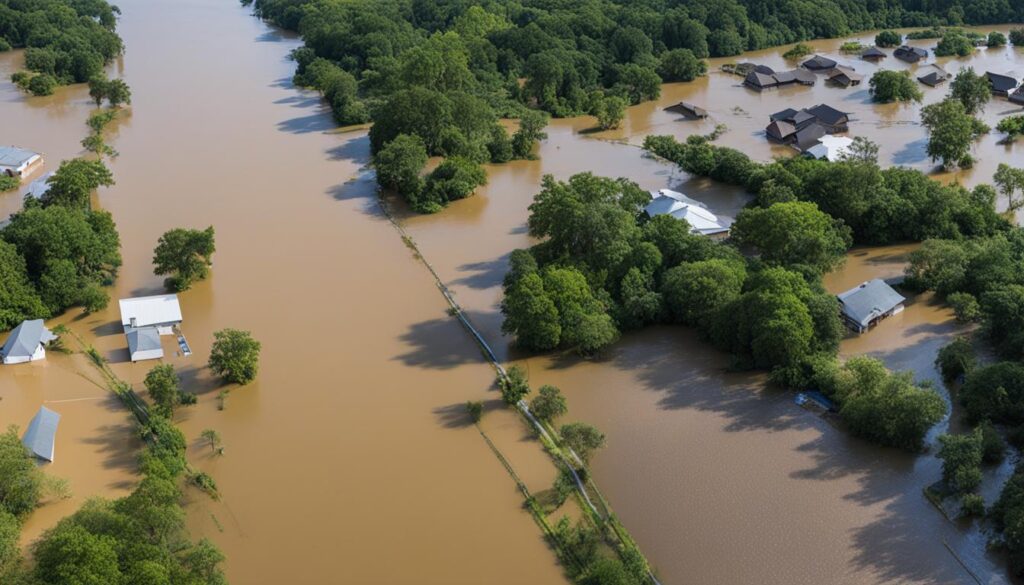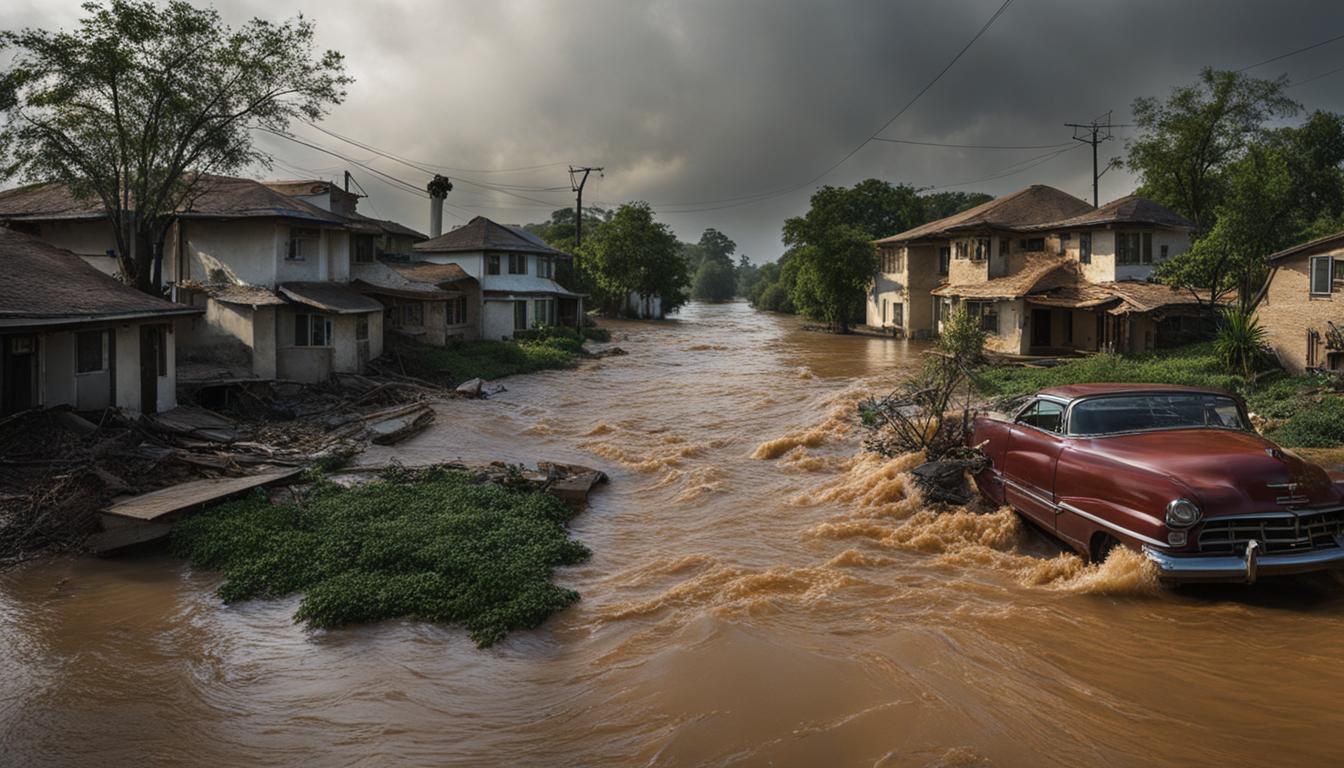Flash floods and river floods are both types of flooding events, but they have distinct differences in terms of their causes and characteristics. Flash floods are typically caused by heavy or excessive rainfall in a short period of time, often less than six hours. They are characterized by fast-rising water levels and can occur suddenly, even without any rainfall if a dam or levee fails. On the other hand, river floods occur when water levels rise over the top of river banks due to factors such as excessive rain from tropical systems, persistent thunderstorms, snowmelt, or ice jams. River floods are usually slower to develop compared to flash floods and can last for an extended period of time. Understanding the differences between these two types of floods is crucial for implementing effective preparedness and response measures.
Key Takeaways:
- Flash floods are caused by heavy or excessive rainfall, while river floods occur when water levels rise over the top of river banks.
- Flash floods have a rapid onset and high water velocities, while river floods develop more slowly and can last for an extended period of time.
- Flash floods can occur suddenly, even without rainfall, if a dam or levee fails.
- Understanding the differences between flash floods and river floods is essential for implementing effective preparedness and response measures.
- Prevention and mitigation strategies for both types of floods involve a combination of structural and non-structural measures.
Causes and Impacts of Flash Floods
Flash floods can be caused by a variety of factors, including heavy rainfall, rapid snowmelt, dam or levee failure, or the sudden release of water from a debris or ice jam. Their rapid onset and high water velocities make them particularly dangerous and capable of causing significant damage to infrastructure, properties, and even loss of life. Flash floods often occur in urban areas where the concrete and asphalt surfaces prevent absorption of water, leading to rapid runoff.
On the other hand, river floods are usually the result of prolonged rainfall, often over several days or weeks, which gradually raises water levels in rivers and causes them to overflow their banks. While river floods can also cause substantial damage, they typically have slower water velocities compared to flash floods. The impacts of flash floods and river floods can vary depending on factors such as the frequency and intensity of the event, the vulnerability of the affected area, and the preparedness and response measures in place.
Understanding the causes and impacts of flash floods and river floods is vital for effective preparedness and response. By analyzing the differences between these two types of floods, individuals, communities, and governments can develop strategies to mitigate the risks associated with these natural disasters, minimize damage, and protect lives.
Risks and Impacts Comparison
| Flash Floods | River Floods |
|---|---|
| Rapid onset | Gradual development |
| High water velocities | Slower water velocities |
| Urban areas | Low-lying areas near rivers |
| Caused by heavy rainfall, dam/levee failure, or sudden water release | Caused by prolonged rainfall and overflowing river banks |
| Significant damage to infrastructure, properties, and loss of life | Substantial damage, slower impact, and lower water velocities |
The table above provides a summary of the key differences in risks and impacts between flash floods and river floods. Understanding these contrasts can inform preparedness and response efforts, guiding the implementation of appropriate measures to reduce the vulnerability of communities and minimize the damage caused by these natural disasters.
Characteristics and Behavior of Flash Floods
Flash floods and river floods may both involve flooding, but they differ in terms of their characteristics and behavior. Flash floods are known for their rapid onset, often occurring within minutes or a few hours of heavy rainfall. They are typically associated with intense, short-duration rainfall events that result in high water velocities and the formation of raging torrents. Flash floods can occur in various locations such as riverbeds, urban streets, and mountain canyons. They can also be triggered by factors other than rainfall, such as dam or levee failures or the sudden release of water from debris or ice jams.
River floods, on the other hand, develop more gradually compared to flash floods. They are usually the result of prolonged rainfall, often over several days or weeks, which gradually raises water levels in rivers and causes them to overflow their banks. Unlike flash floods, river floods tend to have slower-moving water with lower velocities. They typically occur in low-lying areas near rivers and can last for an extended period of time.
To prevent flash floods and river floods, a combination of structural and non-structural measures is necessary. Structural measures include building levees and flood-control channels, while non-structural measures involve land-use planning and early warning systems. These measures aim to reduce the impact of flooding events and enhance overall resilience to flash floods and river floods. By understanding the characteristics and behavior of both types of floods, individuals, communities, and governments can better prepare and respond to these natural disasters.
| Flash Floods | River Floods | |
|---|---|---|
| Characteristics | Rapid onset, high water velocities | Gradual development, slower-moving water |
| Triggering Factors | Heavy rainfall, dam or levee failure, debris or ice jam | Prolonged rainfall, snowmelt, ice jams |
| Duration | Short-lived | Can last for an extended period |
| Locations | Riverbeds, urban streets, mountain canyons | Low-lying areas near rivers |
Understanding the similarities and differences between flash floods and river floods is crucial for implementing effective prevention and mitigation strategies. By taking steps to mitigate the impacts of flooding events, individuals and communities can minimize the risk and damage caused by flash floods and river floods.
Impacts and Aftermath of River Floods
River floods can have devastating impacts on both communities and the environment. When water levels rise over the top of river banks, it results in extensive flooding of low-lying areas, including residential and commercial properties, agricultural fields, and critical infrastructure such as roads and bridges. The aftermath of river floods often involves significant damage and disruption, requiring extensive cleanup and recovery efforts.
“River floods can cause widespread damage to properties, infrastructure, and the local ecosystem,” says Dr. Emily Thompson, a flood expert at the National Flood Research Institute.
“The prolonged presence of floodwaters can lead to structural damage, as well as the growth of mold and contaminants, posing health risks to affected individuals. Additionally, river floods can impact transportation systems, interrupting essential services and hindering emergency response efforts.”
Furthermore, river floods can have long-term ecological consequences. The eroded soil and sediment carried by floodwaters can negatively affect water quality and contaminate local water sources, endangering aquatic life and habitats. The disruption of natural ecosystems can have far-reaching ecological impacts, affecting biodiversity and the health of the surrounding environment.
Preparing for Flood Events
Being prepared for both flash floods and river floods is essential for minimizing the impact of these events. Here are some key measures to consider:
- Create an emergency plan: Develop a plan that outlines evacuation routes, safe locations, and communication strategies for your family or community.
- Stay informed: Keep track of local weather conditions and flood warnings through reliable sources, such as weather radios or mobile phone alerts.
- Secure emergency supplies: Stock up on essential items like food, water, medications, and first aid kits. Ensure you have enough supplies to sustain you for at least 72 hours.
- Protect your property: Install flood barriers, elevate critical equipment, and secure valuables to minimize damage during flooding. Consider purchasing flood insurance for added protection.
- Engage in community efforts: Support or participate in initiatives aimed at improving flood mapping, early warning systems, land-use planning, and promoting flood insurance awareness.
By taking these preparedness measures, individuals, communities, and governments can enhance their overall resilience to both flash floods and river floods.

Key Recommendations for Flood Preparedness:
- Develop an emergency plan.
- Stay informed about weather conditions and flood warnings.
- Secure emergency supplies (food, water, medication, etc.).
- Protect your property (install flood barriers, elevate equipment, secure valuables).
- Engage in community-level efforts (improve flood mapping, early warning systems, land-use planning, and promote flood insurance).
Conclusion
In conclusion, understanding the differences between flash floods and river floods is crucial for effectively preparing and responding to these types of flooding events. Flash floods are characterized by their rapid onset and high water velocities, often triggered by heavy rainfall or sudden water release. On the other hand, river floods develop more gradually and can last for an extended period, as water levels gradually rise over river banks.
Both flash floods and river floods can have significant impacts on communities and the environment. Flash floods, with their intense and fast-moving waters, can cause immediate damage to infrastructure and pose a threat to human life. River floods, although slower to develop, can result in widespread flooding of low-lying areas, leading to property damage, disruption, and ecological consequences.
To mitigate the impacts of flash floods and river floods, it is essential to be prepared. This includes creating an emergency plan, staying informed about weather conditions and flood warnings, and taking steps to protect properties. Additionally, community-level preparedness efforts, such as improved mapping and early warning systems, land-use planning measures, and promoting flood insurance, are crucial for enhancing overall resilience to these natural disasters. By understanding the causes, characteristics, and impacts of flash floods and river floods, individuals, communities, and governments can work together to minimize risks and build a more resilient future.
FAQ
What is the difference between flash floods and river floods?
Flash floods are typically caused by heavy or excessive rainfall in a short period of time, while river floods occur when water levels rise over the top of river banks due to factors such as excessive rain, snowmelt, or ice jams.
What causes flash floods and river floods?
Flash floods can be caused by heavy rainfall, rapid snowmelt, dam or levee failure, or the sudden release of water from a debris or ice jam. River floods are usually the result of prolonged rainfall or other factors that gradually raise water levels in rivers.
How do flash floods and river floods differ in terms of impact?
Flash floods are characterized by their rapid onset, high water velocities, and the potential for significant damage to infrastructure and loss of life. River floods develop more gradually, have slower water velocities, and can result in widespread flooding of low-lying areas.
What are the characteristics and behavior of flash floods?
Flash floods have a rapid onset, often occurring within minutes or a few hours of heavy rainfall. They are associated with intense, short-duration rainfall events, high water velocities, and can occur in various locations including riverbeds, urban streets, and mountain canyons.
What are the impacts and aftermath of river floods?
River floods can cause widespread flooding of low-lying areas, including residential and commercial properties, agricultural fields, and infrastructure such as roads and bridges. They can also lead to long-term damage and disruption, requiring extensive cleanup, repair, and support efforts.
How can I prepare for flash floods and river floods?
It is essential to create an emergency plan, stay informed about weather conditions and flood warnings, and take steps to protect properties. Community-level preparedness efforts, such as improving flood mapping and early warning systems, are also crucial.
Are flash floods and river floods the same?
No, flash floods and river floods are two distinct types of flooding events with different causes, characteristics, and impacts.
 Skip to main content
Skip to main content


